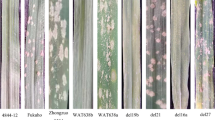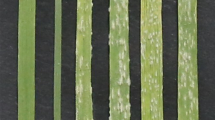Abstract
Key message
A spontaneous Robertsonian T4SlS·4BL translocation chromosome carrying Pm66 for powdery mildew resistance was discovered and confirmed by RNA-seq, molecular marker, and in situ hybridization analyses.
Abstract
Powdery mildew caused by Blumeria graminis f. sp. tritici (Bgt) is a severe disease of bread wheat worldwide. Discovery and utilization of resistance genes to powdery mildew from wild relatives of wheat have played important roles in wheat improvement. Aegilops longissima, one of the S-genome diploid wild relatives of wheat, is a valuable source of disease and pest resistance for wheat. Chromosome 4Sl from Ae. longissima confers moderate resistance to powdery mildew. In this study, we conducted RNA-seq on a putative Chinese Spring (CS)-Ae. longissima 4Sl(4B) disomic substitution line (TA3465) to develop 4Sl-specific markers to assist the transfer of a Bgt resistance gene from 4Sl by induced homoeologous recombination. A pairwise comparison of genes between CS and TA3465 demonstrated that a number of genes on chromosome 4BS in CS were not expressed in TA3465. Analysis of 4B- and 4Sl-specific molecular markers showed that 4BS and 4SlL were both missing in TA3465, whereas 4BL and 4SlS were present. Further characterization by genomic and fluorescent in situ hybridization confirmed that TA3465 carried a spontaneous Robertsonian T4SlS·4BL translocation. Powdery mildew tests showed that TA3465 was resistant to 10 of 16 Bgt isolates collected from different regions of China, whereas CS was susceptible to all those Bgt isolates. The powdery mildew resistance gene(s) in TA3465 was further mapped to the short arm of 4Sl and designated as Pm66.






Similar content being viewed by others
References
Bennett F (1984) Resistance to powdery mildew in wheat: a review of its use in agriculture and breeding programs. Plant Pathol 33:279–300
Boni R, Chauhan H, Hensel G, Roulin A et al (2017) Pathogen-inducible Ta-Lr34res expression in heterologous barley confers disease resistance without negative pleiotropic effects. Plant Biotechnol J 16:245–253
Ceoloni C, Signore G, Ercoli L, Donini P (1992) Locating the alien chromatin segment in common wheat-Aegilops longissima mildew resistant transfers. Hereditas 16:239–245
Chen P, Qi L, Zhou B, Zhang S et al (1995) Development and molecular cytogenetic analysis of wheat-Haynaldia villosa 6VS/6AL translocation lines specifying resistance to powdery mildew. Theor Appl Genet 91:1125–1128
Conner R, Kuzyk A, Su H (2003) Impact of powdery mildew on the yield of soft white spring wheat cultivars. Can J Plant Sci 83:725–728
Dai C, Zhang J, Wu X, Yang X et al (2012) Development of EST markers specifc to Agropyron cristatum chromosome 6P in common wheat background. Acta Agron Sin 38:1791–1801
Du P, Zhuang L, Wang Y, Yuan L et al (2017) Development of oligonucleotides and multiplex probes for quick and accurate identification of wheat and Thinopyrum bessarabicum chromosomes. Genome 60:93–103
Feldman M, Lupton F, Miller T (1995) Wheats. In: Smartt J, Simmonds N (eds) Evolution of crops. Longman Group, London, pp 184–192
Friebe B, Tuleen NB, Jiang J, Gill BS (1993) Standard karyotype of Triticum longissimum and its cytogenetic relationship with T. aestivum. Genome 36:731–742
Friebe B, Zhang P, Linc G, Gill BS (2005) Robertsonian translocations in wheat arise by centric misdivision of univalents at anaphase I and rejoining of broken centromeres during interkinesis of meiosis II. Cytogenet Genome Res 109:293–297
Fried P, Mackenzie D, Nelson R (1981) Yield loss caused by Erysiphe graminis f. sp. tritici on single culms of “Chancellor” wheat and four multilines. Z Pflanzenschutz 88:256–264
Grabherr M, Haas B, Yassour M, Levin J et al (2011) Full-length transcriptome assembly from RNA-Seq data without a reference genome. Nat Biotechnol 29:644–652
Gupta P, Langridge P, Mir R (2010) Marker-assisted wheat breeding: present status and future possibilities. Mol Breed 26(1):145–161
He Z, Xia X, Chen X, Zhang Q (2011) Progress of wheat breeding in China and the future perspective. Acta Agron Sin 37:202–215
Huang X, Zhu M, Zhuang L, Zhang S et al (2018) Structural chromosome rearrangements and polymorphisms identified in Chinese wheat cultivars by high-resolution multiplex oligonucleotide FISH. Theor Appl Genet 131:1967–1986
Johnson R (1992) Past, present and future opportunities in breeding for disease resistance, with examples from wheat. Euphytica 63:3–22
Karsai I, Vida G, Petrovics S, Petcu E et al (2012) Assessment of the spatial genotypic and phenotypic diversity present in the various winter wheat breeding programs in Southeast Europe. Euphytica 186:139–151
Li Q, Niu Z, Bao Y, Tian Q et al (2016) Transcriptome analysis of genes related to resistance against powdery mildew in wheat-Thinopyrum alien addition disomic line germplasm SN6306. Gene 1:5–17
Li S, Lin Z, Liu C, Wang K et al (2017) Development and comparative genomic mapping of Dasypyrum villosum 6V#4S-specific PCR markers using transcriptome data. Theor Appl Genet 130:2057–2068
Liu X, Richard R, Jia J, Dong Y (2002) Assessing genetic diversity of Aegilops longissima Schweinf and Muschl. by RAPD markers. J Plant Genet Resour 3:1–6
Liu W, Koo D, Xia Q, Li C et al (2017) Homoeologous recombination-based transfer and molecular cytogenetic mapping of powdery mildew-resistant gene Pm57 from Aegilops searsii into wheat. Theor Appl Genet 130:841–848
Luo P, Zhang H, Shu K, Wu X et al (2009) The physiological genetic effects of 1BL/1RS translocated chromosome in “stay green” wheat cultivar CN17. Can J Plant Sci 89:1–10
McIntosh R, Dubcovsky J, Rogers W, Morris C et al (2017) Catalogue of gene symbols for wheat. 2017. Supplement. Annu Wheat Newsl 53:107–128
Morgounov A, Tufan H, Sharma R, Akin B et al (2012) Global incidence of wheat rusts and powdery mildew during 1969–2010 and durability of resistance of winter wheat variety Bezostaya 1. Eur J Plant Pathol 132:323–340
Patel R, Jain M (2012) NGS QC Toolkit: a toolkit for quality control of next generation sequencing data. PLoS ONE 7:e30619
Pertea G, Huang X, Liang F, Antonescu V et al (2003) TIGR Gene Indices Clustering Tools (TGICL): a software system for fast clustering of large EST datasets. Bioinformatics 19:651–652
Rey E, Abrouk M, Keeble-Gagnere G, Karafifiatova M et al (2018) Transcriptome reprogramming due to the introduction of a barley telosome into bread wheat affects more barley genes than wheat. Plant Biotechnol J 16:1767–1777
Sears ER (1952) Misdivision of univalents in common wheat. Chromosoma 4:535–550
Sheng H, See D, Murray T (2012) Mapping QTL for resistance to eyespot of wheat in Aegilops longissima. Theor Appl Genet 125:355–366
Shi Q, Zhang X, Duan X (1987) Identification of isolates of Blumeria graminis f. sp. tritici. Sci Agric Sin 20:64–70
Tan C, Li G, Cowger C, Carver B et al (2018) Characterization of Pm63, a powdery mildew resistance gene in Iranian landrace PI 628024. Theor Appl Genet 132:1137–1144
van Dijk EL, Auger H, Jaszczyszyn Y, Thermes C (2014) Ten years of next-generation sequencing technology. Trends Genet 30:418–426
Wang Z, Li L, He Z, Duan X et al (2005) Seedling and adult plant resistance to powdery mildew in Chinese bread wheat cultivars and lines. Plant Dis 89:457–463
Wang Z, Gerstein M, Snyder M (2009) RNA-Seq: a revolutionary tool for transcriptomics. Nat Rev Genet 10:57–63
Wang K, Lin Z, Wang L, Wang K et al (2018) Development of a set of PCR markers specific to Aegilops longissima chromosome arms and application in breeding a translocation line. Theor Appl Genet 131:13–25
Xia Q, Mai Y, Dong Z, Liu W (2018) Identification of powdery mildew resistance resources from wheat-wild relative disomic addition lines and development of molecular markers of alien chromosome-specificity. J Henan Agric Sci 47:64–69
Xin M, Wang X, Peng H, Yao Y et al (2012) Transcriptome comparison of susceptible and resistant wheat in response to powdery mildew infection. Genom Proteom Bioinform 10:94–106
Xing L, Hu P, Liu J, Witek K et al (2018) Pm21 from Haynaldia villosa encodes a CC-NBS-LRR protein conferring powdery mildew resistance in wheat. Mol Plant 11:874–878
Zeller FJ (1973) 1B/1R wheat-rye chromosome substitutions and translocations. In: Sears ER, Sears LMS (eds) Proceedings of the 4th international wheat genetics symposium. University of Missouri Agricultural Experimental Station, Columbia, pp 209–221
Zeller F, Fuchs E (1983) Cytology and disease resistance of 1A/1R and some 1B/1R wheat-rye translocation cultivars. Z. Pflanzenzuecht 90:285–296
Zhang J, Zheng H, Li Y, Li H et al (2016) Coexpression network analysis of the genes regulated by two types of resistance responses to powdery mildew in wheat. Sci Rep 6:23805
Zhang D, Zhu K, Dong L, Liang Y et al (2019) Wheat powdery mildew resistance gene Pm64 derived from wild emmer (Triticum turgidum var. dicoccoides) is tightly linked in repulsion with stripe rust resistance gene Yr5. Crop J. https://doi.org/10.1016/j.cj.2019.03.003
Zou S, Wang H, Li Y, Kong Z et al (2018) The NB-LRR gene Pm60 confers powdery mildew resistance in wheat. New Phytol 218:298–309
Acknowledgements
We thank Dr. Yuli Song from Institute of Plant Protection, Henan Academy of Agricultural Sciences, for providing Bgt isolates collected in Henan Province, Drs. Rama S. Kota and Jan Dvorak for providing seeds of TA3465, and W. John Raupp and Dr. Robert McIntosh for critical reading of the manuscript. This project was financially supported by National Natural Science Foundation of China (Grant No. 31571658), the State Key Laboratory of Crop Genetics and Germplasm Enhancement at Nanjing Agricultural University, China (ZW2011002), Henan Province Special Major Science and Technology Project (161100110400), and the State Key Laboratory of Wheat and Maize Crop Science at Henan Agricultural University, China (39990022).
Author information
Authors and Affiliations
Contributions
This study was conceived by WL and PM; HL performed in situ hybridization. ZD and SS conducted RNA-seq data analysis and molecular marker design; CM conducted molecular marker analysis; QX and PM evaluated responses to Bgt isolates; XT prepared RNA samples; WL and HL wrote the manuscript; and D-HK and BF verified the chromosomal constitution of TA3465 maintained in KSU and amended the manuscript. All authors have read and approved the final manuscript.
Corresponding authors
Ethics declarations
Conflict of interest
The authors declare that they have no conflicts of interest.
Additional information
Communicated by Albrecht E. Melchinger.
Publisher's Note
Springer Nature remains neutral with regard to jurisdictional claims in published maps and institutional affiliations.
Electronic supplementary material
Below is the link to the electronic supplementary material.
Rights and permissions
About this article
Cite this article
Li, H., Dong, Z., Ma, C. et al. A spontaneous wheat-Aegilops longissima translocation carrying Pm66 confers resistance to powdery mildew. Theor Appl Genet 133, 1149–1159 (2020). https://doi.org/10.1007/s00122-020-03538-8
Received:
Accepted:
Published:
Issue Date:
DOI: https://doi.org/10.1007/s00122-020-03538-8




